Testing, testing...
Labels: random

Labels: random
Patons diploma gold, dark green: 100 g, 240 m
Cygnet wool rich 4ply, sagey khaki: 50 g, 205 m
Labels: funny, red marker


Labels: Knitting, ponderings
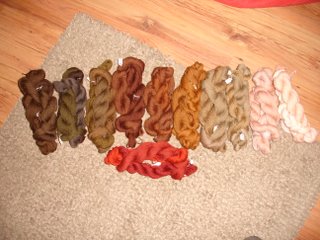 Each of those bundles is a group of three skeins of very fine two-ply. As far as I can tell, there are no dye-lots in this yarn, and each skein is a subtly different colour. I spent my whole lunch-hour sorting these bargain £1 skeins into closely-matched groups of three one day at the end of November.
The yarn is a very fine two-ply and completely unlabelled, and I think it's supposed to be used for crewelwork or some other kind of embroidery:
Each of those bundles is a group of three skeins of very fine two-ply. As far as I can tell, there are no dye-lots in this yarn, and each skein is a subtly different colour. I spent my whole lunch-hour sorting these bargain £1 skeins into closely-matched groups of three one day at the end of November.
The yarn is a very fine two-ply and completely unlabelled, and I think it's supposed to be used for crewelwork or some other kind of embroidery:
 However, this little lot is going for two trips through the spinning wheel before I do anything with it. First I'm going to tighten the existing ply, then I'm going to run those groups of three back through the wheel to produce a six-ply yarn. Because none of the yarns are quite the same colour, I should end up with some wonderful rich, heathered colours.
Afterwards, I plan something stranded and stunning. I'm vaguely hoping to have enough for a sweater, having been very inspired at the time by Bohus designs. Even after futher plying, this will still be a rather fine yarn, so this will be a rather long-term project.
But I'm very much looking forwards to it!
However, this little lot is going for two trips through the spinning wheel before I do anything with it. First I'm going to tighten the existing ply, then I'm going to run those groups of three back through the wheel to produce a six-ply yarn. Because none of the yarns are quite the same colour, I should end up with some wonderful rich, heathered colours.
Afterwards, I plan something stranded and stunning. I'm vaguely hoping to have enough for a sweater, having been very inspired at the time by Bohus designs. Even after futher plying, this will still be a rather fine yarn, so this will be a rather long-term project.
But I'm very much looking forwards to it!
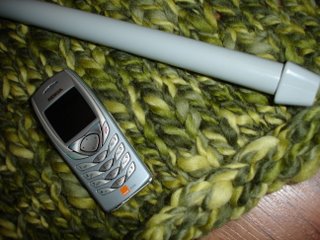 20mm needles are the *wierdest* things to try and handle after knitting with 2.5mm DPNs for a week. The largest needles I have ever used before have been the 8mm ones used for Mask, and I found those uncomfortably large to handle.
Knitting with 20mm needles requires completely different movements to 'normal' knitting, at least for me. You can't just use your hands, you have to move your whole arms. There's certainly no such thing as a small movement!
But at least it grows quickly. This is one evening's work; mobile phone included for scale:
20mm needles are the *wierdest* things to try and handle after knitting with 2.5mm DPNs for a week. The largest needles I have ever used before have been the 8mm ones used for Mask, and I found those uncomfortably large to handle.
Knitting with 20mm needles requires completely different movements to 'normal' knitting, at least for me. You can't just use your hands, you have to move your whole arms. There's certainly no such thing as a small movement!
But at least it grows quickly. This is one evening's work; mobile phone included for scale:
 I adore the colours, but really don't want to knit socks that looks like this:
I adore the colours, but really don't want to knit socks that looks like this:
 I'm hoping that because I've been splitting and pre-drafting the roving kinda randomly, that any pooling that does occur will not be as regular.
But now, I need to decide what to do with this. I think I would like to knit a pair of socks in the yarn spun from this roving, but this was my first foray with the Ashford, and some of the earlier joins in the singles were very poor indeed. Once plied, they're probably structurally OK (can you feel the confidence??), but it has left ugly 'tufts' on the yarn that I wouldn't want in a sock. So I need to decide whether to do something totally random with this, as a single skein, and to spin up more yarn for socks; or to use this skein and just do one more...? I suppose I could try sampling this yarn to see what a sock would look like, and then spin two more skeins... Any ideas for what to do with 140m of colourfully variegated sock weight yarn?
I'm hoping that because I've been splitting and pre-drafting the roving kinda randomly, that any pooling that does occur will not be as regular.
But now, I need to decide what to do with this. I think I would like to knit a pair of socks in the yarn spun from this roving, but this was my first foray with the Ashford, and some of the earlier joins in the singles were very poor indeed. Once plied, they're probably structurally OK (can you feel the confidence??), but it has left ugly 'tufts' on the yarn that I wouldn't want in a sock. So I need to decide whether to do something totally random with this, as a single skein, and to spin up more yarn for socks; or to use this skein and just do one more...? I suppose I could try sampling this yarn to see what a sock would look like, and then spin two more skeins... Any ideas for what to do with 140m of colourfully variegated sock weight yarn?
 I liked it so much that I went looking for the accompanying pattern book. Ohh... well. There are a few garments in there that I would consider knitting, but I'm not sure if they're right for the yarn. Admittedly, I'm not sure what *is* right for the yarn - maybe just leaving it in skeins is enough. It doesn't help that there is no hint of lustre in the book's photographs; this is a lustrous yarn, folks; if you don't want to play to it, at least don't hide it! Nothing p!sses people off more than finding they've knit a garment that has been misrepresented in the photographs (believe me: ask about Minnie sometime. She's still awaiting surgery...). In fact, in some of the photographs, the yarn looks really tired and sad:
I liked it so much that I went looking for the accompanying pattern book. Ohh... well. There are a few garments in there that I would consider knitting, but I'm not sure if they're right for the yarn. Admittedly, I'm not sure what *is* right for the yarn - maybe just leaving it in skeins is enough. It doesn't help that there is no hint of lustre in the book's photographs; this is a lustrous yarn, folks; if you don't want to play to it, at least don't hide it! Nothing p!sses people off more than finding they've knit a garment that has been misrepresented in the photographs (believe me: ask about Minnie sometime. She's still awaiting surgery...). In fact, in some of the photographs, the yarn looks really tired and sad:

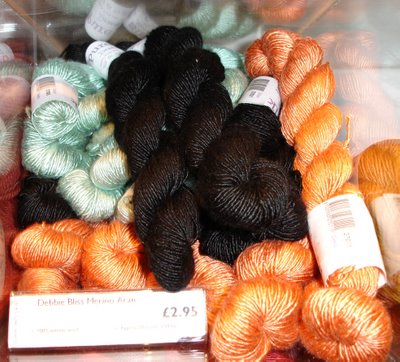
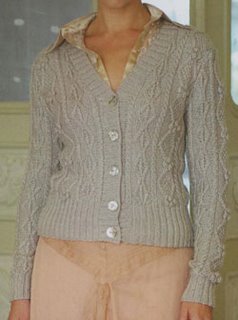



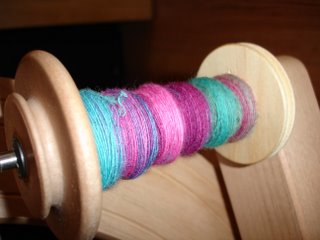 The wheel, I love; the top, I'm not so sure about. It's probably because it's been stashed for ages, but it feels pretty compacted and refuses to draft. I'm trying to pre-draft, but even that isn't helping all that much; it sticks and jumps and won't draft smoothly. If I want to spin this evenly, I need to find a way to help open it out again. I'd think about carding or combing, but the roving's already space-dyed, and I'm not sure I want to mix it all up.
________________________________________________________________
1 OK, I could have just assembled it without finishing - the wood is nice and smooth anyway - but I just *know* that within months it would be looking grubby and sorry for itself, especially around the treadles and those places where one's hands repeatedly touch... So I wanted to seal the wood, so that all muck and rubbish would not soak into the grain and would be easily removed.
The wheel, I love; the top, I'm not so sure about. It's probably because it's been stashed for ages, but it feels pretty compacted and refuses to draft. I'm trying to pre-draft, but even that isn't helping all that much; it sticks and jumps and won't draft smoothly. If I want to spin this evenly, I need to find a way to help open it out again. I'd think about carding or combing, but the roving's already space-dyed, and I'm not sure I want to mix it all up.
________________________________________________________________
1 OK, I could have just assembled it without finishing - the wood is nice and smooth anyway - but I just *know* that within months it would be looking grubby and sorry for itself, especially around the treadles and those places where one's hands repeatedly touch... So I wanted to seal the wood, so that all muck and rubbish would not soak into the grain and would be easily removed.
 I had the shoulders seamed, the sleeves attached and the collar picked up and about three centimetres worked by the time Stu arrived. It took a car journey and a film (V for Vendetta; still excellent the second time round - watch it!) to finish the collar, which is a tall turtleneck, and I got up early the next morning (again!) to seam the sides and under arms.
I failed utterly to take any photos of the finished garment, modelled or otherwise, but I did get snaps of this pair of lizard-heads, which together show the importance of designing your intarsia motif with the direction of all those little 'V's in mind (I reversed the motif for the back of the sweater; the original designer got it right!):
I had the shoulders seamed, the sleeves attached and the collar picked up and about three centimetres worked by the time Stu arrived. It took a car journey and a film (V for Vendetta; still excellent the second time round - watch it!) to finish the collar, which is a tall turtleneck, and I got up early the next morning (again!) to seam the sides and under arms.
I failed utterly to take any photos of the finished garment, modelled or otherwise, but I did get snaps of this pair of lizard-heads, which together show the importance of designing your intarsia motif with the direction of all those little 'V's in mind (I reversed the motif for the back of the sweater; the original designer got it right!):


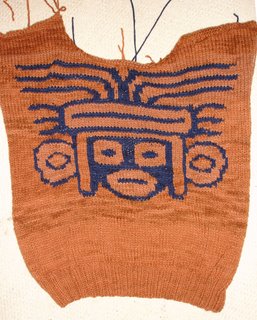 And both sleeves:
And both sleeves:
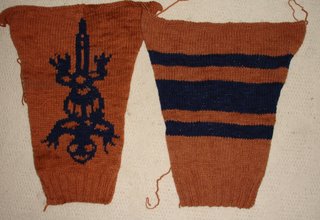 And the back looks like this:
And the back looks like this:
 So my schedule is as follows:
So my schedule is as follows: